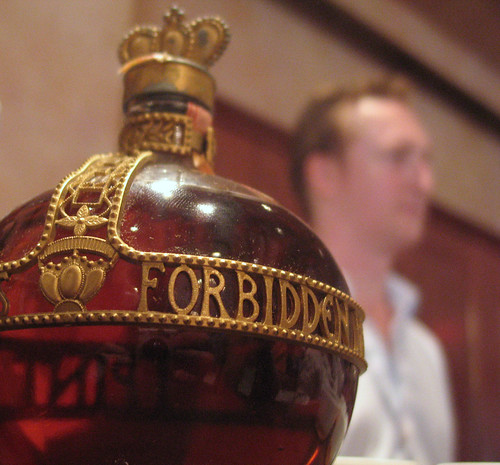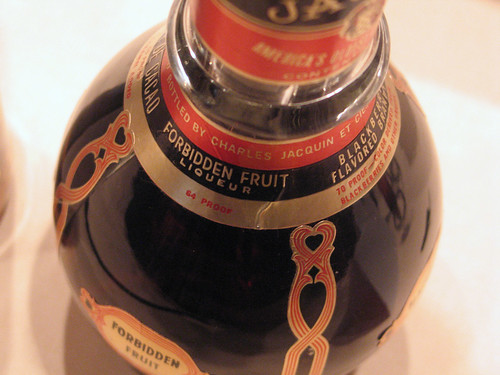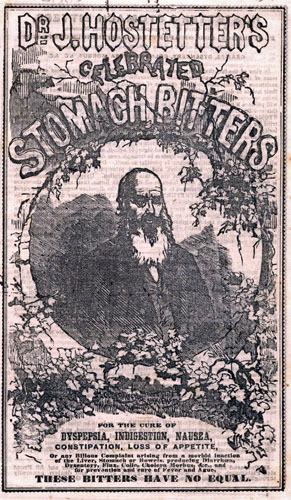There’s been a new trend the last several months where cocktail bloggers have been offered review samples of products. “Hey, free booze!” you might say. Not so fast. A lot of these, as the bloggers who were the recipients of these offers will confirm, were crap trendy products completely uninteresting to them. (Shocking pink, impossibly sweet liqueurs, and the like.)
A while back I started getting offered samples as well, and they were invariably vodka. I must confess to not having a lot of interest in vodka, preferring spirits that actually taste like something. Yes yes yes, I can get into lengthy argu– er, discussions with vodka drinkers about the subtleties of flavor in a well-made vodka, and they’re absolutely right. I just don’t enjoy drinking plain vodka for the most part (unless it’s Zubrówka), and it bores me. Not only that, I’m a believer in Audrey Saunders’ adage that for the most part a vodka cocktail is a cocktail with a hole in it; any subtlety in a vodka’s flavor pretty much disappears when it’s mixed.
Imagine my delight, then, when I was offered a sample of something that not only interested me but excited me. Now that the disclosure is out of the way, let’s talk about a rum I’ve been curious about for a while but until recently had never tried until I got a bottle in the mail — Ron Matusalem.
Matusalem is a rum from the Dominican Republic, but they are quick to point out that they are a Cuban spirit. How does that work? In 1872 the Matusalem distillery was founded in Santiago de Cuba by two Spanish immigrants, Benjamin and Eduardo Camp, and their partner Evaristo Álvarez. They brought along the Solera system from Spain, used to make Spain’s sherries and brandies, in which a series of barrels are used to age a wine or spirit. A portion from the last and oldest barrel is bottled, then that barrel is filled from the next-to-last barrel, etc. The aging process is reflected in the name they chose for their rum, which is Spanish for Methuselah, the old patriarch who according to biblical legend lived to an age of 969 (nine hundred four years of retirement — golf, shuffleboard and getting in his wife’s hair … oy) and a nod to the old Spanish proverb, “Esto es màs viejo que Matusalem” — “It’s older than Methuselah.”
The beautifully crafted rum took off, and by the mid-1950s Matusalem had half of the Cuban rum market. Then we all know what happened in Cuba four years later …
The Álvarez family and their company were forced into exile, and the brand nose-dived. Fortunately, in the mid-1990s, Claudio Álvarez Salazar, great-grandson of Evaristo, won a court settlement granting the Matusalem brand back to him and his family. He took what was left of the company back to its roots, started making their rums the old way and … voilà! Ron Matusalem was relaunched in 2002.
Here’s the stuff they sent me a few weeks ago:
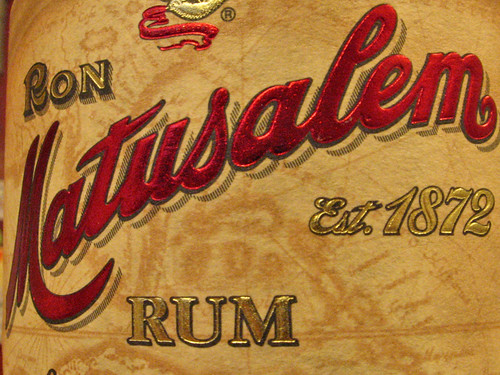 Ron Matusalem Gran Reserva, 15 years old. “The Cognac of Rums” was what it was called back in the day, according to the distiller. They describe it as a “super premium” rum but also call for its inclusion in cocktails. Well, let’s give it a try, shall we?
Ron Matusalem Gran Reserva, 15 years old. “The Cognac of Rums” was what it was called back in the day, according to the distiller. They describe it as a “super premium” rum but also call for its inclusion in cocktails. Well, let’s give it a try, shall we?
This is the first time I’ve ever evaluated a spirit for a review, even just as semi-formal one, but I want to do it right. Fortunately a month ago Wesly and I took a course at Tales of the Cocktail with Paul Pacult called “How to Taste Like A Professional,” which comes in handy for this sort of thing. Our palates aren’t nearly as educated as his, but we can certainly continue to train them by taking his advice, which is basically to smell and taste the spirit, do it properly, and let the spirit sit in the glass for several minutes to see what else it releases as it aerates. Sounds like fun.

First off, it’s pretty stuff; a beautiful amber/honey color in the glass. First sniff … sugar cane. Then vanilla, and plenty of it. “Grandmother’s attic,” was one of Gregg’s observations when he, Wes and I first tasted this a week or so ago, and he meant that in the best possible way. After a few minutes more vanilla, then a buttery aroma developed. Five to seven minutes in the glass, and I actually laughed in surprise — I got the flavor of pecan pralines, right out of New Orleans. (Unsurprising, as the ingredients in pralines are sugar, butter, pecans and sometimes rum.) Really delightful.
Now, let’s have a taste … a bit of alcohol up front, although it’s bottled at 40%. It’s pleasantly hot, though; I get that not so much on the tongue but on my lips. Despite that bit of heat it’s very smooth. We all found that 5 to 8 minutes in the glass eliminated the burn. It’s delicate and refined but wouldn’t be easy to overpower. Very complex, with plenty of vanilla, butter, toasted pecans, a touch of cinnamon. More aeration also brought out more oak wood as well. It had a nice finish too; I could still taste it almost 15 minutes later. Hoo-boy. We poured some more. This is really terrific stuff. Not too sweet, with more of a brown sugar flavor that strong molasses, crisp, woody, buttery caramel, yet still dry enough. The first time we tasted this we also tasted an actual Cuban rum, Havana Club Añejo (um … we teleported to Canada to do that … yeah, that’s it), and I have to say that Fidel’s boys got their butts kicked. Clearly Matusalem was the superior product.
Now, is this a rum I want to reserve for sipping only? I’m tempted, but I’m a believer in Gary Regan’s adage of “Garbage In, Garbage Out” when it comes to cocktails, and I’m not shy about using the good stuff. I certainly will sip this on occasion, but what else shall we try? One of my favorite ways to evaluate a whiskey is to use it in an Old Fashioned, and I’ve been doing that with añejo tequila these days as well. So let’s try one of those … Wes did the honors.
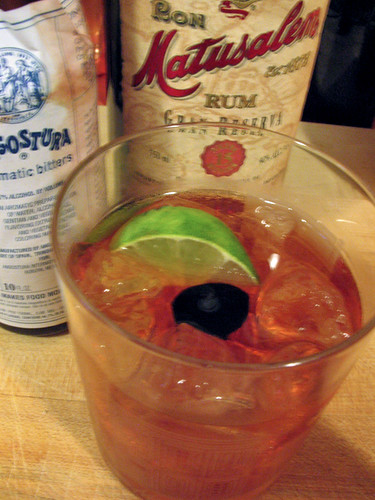
Rum Old Fashioned
2-1/2 ounces Ron Matusalem Gran Reserva rum.
1 teaspoon simple syrup.
2 dashes Angostura Bitters.
1 lime wedge.
1 good-quality cocktail cherry.
Combine rum, syrup and bitters in a mixing glass and stir for 30 seconds. Strain into an Old Fashioned glass over fresh ice. Garnish with the cherry and the lime wedge, but do not squeeze the lime; leave the option for the drinker.
This made an absolutely gorgeous Old Fashioned. Wes went light on the syrup, as we didn’t want to oversweeten. The lime makes a lovely garnish and would probably complement the flavor nicely, but we thought leaving the squeezing up to the individual would be a good idea if you’re serving these.
Okay, what else shall we do? I thought of a Daiquiri, and that’d be a great way to drink this stuff too; keeping it simple with lime and sugar. I wanted to try and see how it’d blend with other ingredients, though, and while thinking of something Daiquiri-like the lightbulb went off over my head. I went to our cocktail bookshelf and dug out Jeff “Beachbum” Berry’s most recent and stupendously wonderful book, Sippin’ Safari and flipped around until I found the recipe I was thinking about.
This is a drink by the man who started the whole world of tiki cocktails and cuisine, a native of New Orleans named Ernest Raymond Beaumont Gantt, who later changed his name to Donn Beach, but was known the world ’round as Don the Beachcomber. Jeff says this drink “is a good example of how Donn had mastered the art of blending rums of different body, character and origin to create a flavor no one rum could approach on its own. Try this with 2 ounces of only one of the rums listed above, and you’ll get a serviceable but utterly unexceptional Daiquiri.”
Don’s original recipe called for Golden Stag rum; Jeff suggests substituting Appleton Special Gold from Jamaica, but I decided to let the Cuban spirit by way of the Dominican Republic take the forefront. The other two rums called for are a half-ounce each of “aged dark Jamaican rum” — Jeff recommends Appleton Estate Extra, which I absolutely love (talk about the Cognac of rums, yeesh!) — and Louisiana rum, for which I used Old New Orleans Dark 3 Year Old rum.
Golden Stag
1 ounce Ron Matusalem Gran Reserva rum.
1/2 ounce Appleton Estate Extra rum.
1/2 ounce Old New Orleans Dark rum.
1/2 ounce fresh lime juice.
1/2 ounce simple syrup.
1 dash Angostura Bitters.
Lime wheel.
Shake with ice for at least 12 seconds, and strain into a cocktail glass. Garnish with the lime wheel.
God … what a gorgeous drink! This ain’t no ordinary Daiquiri; blending those rums together creates a new and wonderful whole, and the Matusalem anchor works great. The dash of bitters helps to tie it all together, with the sweet and tart in balance.
I’d say go ahead and mix Matusalem Gran Reserva with just about anything you care to (although if you do a Cuba Libre I’d go easy on the cola). Definitely sip this when you’re in the mood for a sippin’ rum, though. And the clincher? The distillery describes this as a “super premium” rum, but Beverage Warehouse carries this for $29.95! That’s hardly a premium price, and at that price you can afford to go through this without too much worry about your wallet.
And there you have it, my first review from an actual professional sample. That was fun. Let’s do it again!

